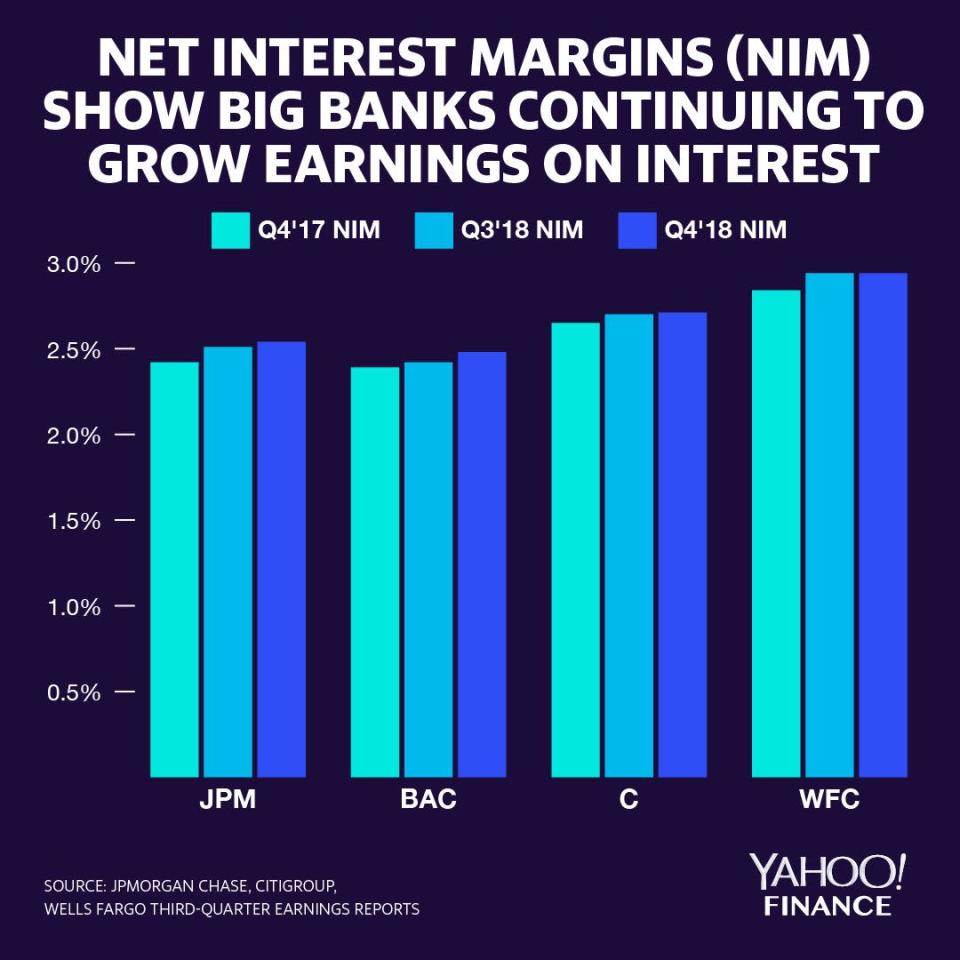Banks report pressures on loan growth in fourth-quarter earnings
A running theme for big bank earnings is wrangling with slowing loan growth - the line of business largely considered to be the “bread and butter” of the banking business. The tepid pace of lending comes amid plunging readings on consumer confidence and declining manufacturing activity.
Year-over-year, loan books (net of allowances for losses) grew by 6% at JPMorgan Chase (JPM), 3% at Citigroup (C), and 1.2% at Bank of America (BAC). Wells Fargo (WFC), which said it will continue to face an asset cap from the Federal Reserve through the end of 2019, actually saw loans shrink by 0.2% year-over-year.
Dick Bove, chief strategist at Rafferty Holdings, told Yahoo Finance that commercial and consumer loans “have slowed down dramatically,” pointing out that the numbers are relatively low compared to the 8% loan growth that banks saw in the beginning of 2018.
“There’s been a significant reduction in the health of lending,” Bove said.
‘Tale of two cities’
But the banks themselves have not sounded the alarms. At the country’s largest bank, JPMorgan Chase CEO Jamie Dimon said, “We have no problem seeing loan books shrink,” adding that he prioritizes the company’s banking relationships above the number of new loans.
“There are reasons that we stay in a business knowing there’s going to be a cycle, and we’re not going to be children in this cycle,” Dimon said on a conference call on Tuesday.
Still, JPMorgan Chase CFO Marianne Lake said she sees “a Tale of Two Cities” where some pockets of lending are healthy but where others are “tightening.” She pointed to challenging conditions in home lending and commercial real estate but said JPMorgan Chase was able to squeeze slightly better than industry-standard growth in commercial and industrial loans.
Mortgage markets have been hampered by rising rates, and the Fed reported that loan officers have tightened their standards on construction loans for commercial real estate.
Citigroup’s earnings revealed some headwinds in consumer credit as well. The company reported a “drag” on U.S. mortgage revenues and reported “roughly flat” revenues from its portfolio of branded credit cards, a staple for the bank.
At Bank of America, CEO Brian Moynihan broadly projected total loan growth for his bank to be in the “low single digits,” adding that their business segment performances in 2019 could vary “depending on economic growth.”
Banks still making money on interest

Despite the sluggish loan growth, banks are still improving the return on their interest-bearing assets. Net interest margin — the difference between interest collected from loans and interest paid on deposits - increased year-over-year and quarter-over-quarter at all four of the big banks with the exception of the asset-capped Wells Fargo, where quarter-over-quarter NIM was unchanged. Improving NIM shows that despite four rate hikes in 2018, profitability is fine; deposit costs are not rising faster than income collected on loans.
Ahead of earnings, RBC Capital Markets’s Gerard Cassidy wrote that investors should focus on three types of bank stocks: those that return on capital, those with a “risk-on” strategy and those that feature multiple revaluation.
As the largest banks’ trading desks get slammed by volatility, RBC cast light on the less capital markets-reliant super-regional banks like M&T Bank Corporation (MTB), which Cassidy dubbed the “Super Bowl Champions of Banking.” RBC said M&T was one of the best performing U.S. banks because of its ability to return 146% of earnings to shareholders in dividends and stock buybacks, which was helped by “robust” commercial and industrial loan growth and controlled costs.
Loan growth at regional banks will also vary depending on the economic health of different parts of the country, calling regional bank performance into view. In the Fed’s Beige Book for January, the New York, Dallas and San Francisco districts reported slower loan growth but, Chicago and Kansas City saw an increase in lending.
Those geographic differences could also differentiate the regional banks in this noisy quarter of bank earnings.
Brian Cheung is a reporter covering the banking industry and the intersection of finance and policy for Yahoo Finance. You can follow him on Twitter @bcheungz.
Read more:
Banks hope to shake off concerns over a global recession in earnings
Powell, Clarida insist the Fed will be ‘patient’ with monetary policy
5 game-changing papers from this year’s largest gathering of economists
Wells Fargo economist: It’s time to abandon the yield curve
Congress may have accidentally freed nearly all banks from the Volcker Rule

